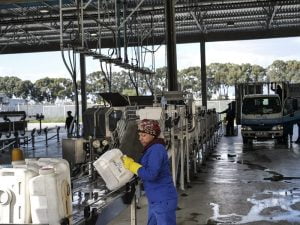JG Afrika and Project Assignments were appointed by the City of Cape Town to build a new portable-flush toilet cleaning facility at the Borcherds Quarry Wastewater Treatment Works (WWTW) site to provide a clean, hygienic, automated and dignified disposal, cleaning and handling process.
New facility
 There are currently more than 20 000 portable flush toilets being used in Cape Town by members of impoverished areas where waterborne sewer systems are not possible to install. Each of these toilets, which need to be emptied and cleaned every second day, are brought to a facility at Borcherds Quarry WWTW. The old facility experienced capacity constraints and it no longer provided a hygienic environment for personnel as each toilet had to be emptied and cleaned by hand.
There are currently more than 20 000 portable flush toilets being used in Cape Town by members of impoverished areas where waterborne sewer systems are not possible to install. Each of these toilets, which need to be emptied and cleaned every second day, are brought to a facility at Borcherds Quarry WWTW. The old facility experienced capacity constraints and it no longer provided a hygienic environment for personnel as each toilet had to be emptied and cleaned by hand.
Hygienic, safe and efficient
Located adjacent to the existing facility, the new larger building houses South Africa’s first automatic portable-flush toilet cleaning plant. It receives, empties, cleans, dries and disinfects the toilets automatically to eliminate human contact except when unloading them from the trucks.  The dry and disinfected toilets are then conveyed via another conveyor to a dispatch area where they are collected for delivery back to the various informal settlements.
The dry and disinfected toilets are then conveyed via another conveyor to a dispatch area where they are collected for delivery back to the various informal settlements.
It efficiently, safety and hygienically receive septic tankers at three dedicated discharge points, which have been specially-designed to eliminate the extensive spillages that were experienced in the past.
The facility also features a specially designed screening area to eliminate blockages that were caused by septic tankers inadvertently discharging large contents such as bricks and water conveyors to transport the screenings and faecal waste.
Another highlight of this new state-of-the-art operation is the use of treated effluent from the WWTW to clean the toilets, as opposed to potable water as was done before. While drinking water is still used with detergents to disinfect the toilets, the design has brought some relief to a recently drought-stricken area.
The building also houses new offices, toilets and a viewing deck with a control room in order to monitor and control the facility by a new SCADA system from above.
Challenges
Some of the challenges of the project included the very high accuracy in levels demanded by the mechanical engineering equipment. This is in addition to the need for extensive coordination of the design of the roof structure and its various openings to accommodate all of the mechanical and electrical services, while the precise positioning of the bases for the conveyor belt was also a technically complex undertaking.
